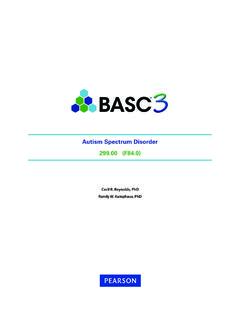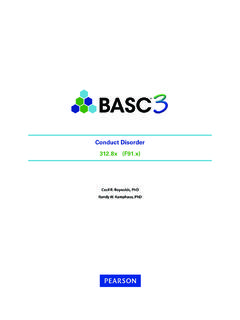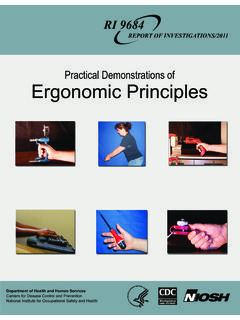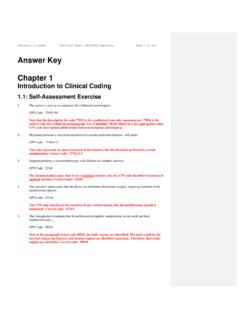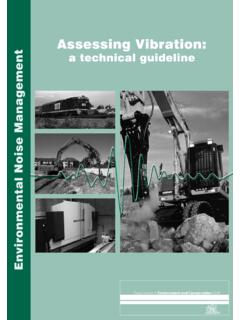Transcription of Assessment of repetitive tasks of the upper limbs (the ART ...
1 Health and Safety ExecutiveThe ART tool Page 1 of 16 The Assessment of repetitive tasks (ART) tool is designed to help you risk assess tasks that require repetitive moving of the upper limbs (arms and hands). It helps you to assess some of the common risk factors in repetitive work that contribute to the development of upper limb disorders (ULDs).ART is aimed at those responsible for designing, assessing, managing and inspecting repetitive work. It can help identify those tasks that involve significant risks and where to focus risk-reduction measures. It will be useful to employers, safety representatives, health and safety practitioners, consultants and information on ART, including online training on how to use the tool, can be found at of repetitive tasks of the upper limbs (the ART tool)Guidance for employersINDG438 Published 03/10 The ART tool Page 2 of 16 Health and Safety ExecutiveAssessment guideRepetitive tasks are made up of a sequence of upper limb actions, of fairly short duration, which are repeated over and over again, and are almost always the same (eg stitching a piece of cloth, manufacturing one part, packaging one item).
2 ART is most suited for tasks that: involve actions of the upper limbs ; repeat every few minutes, or even more frequently; and occur for at least 1 2 hours per day or shift. The tasks are typically found in assembly, production, processing, packaging, packing and sorting work, as well as work involving the regular use of hand tools. ART is not intended for display screen equipment (DSE) is made up of three sections: The Assessment guide this provides detailed information about how to use the tool, the risk factors and the Assessment criteria. Read it carefully before using the tool. The flow chart this provides an overview of the Assessment process. It also guides experienced users through the tool fairly quickly. The task description form and score sheet this provides a place to record information about the task as well as the findings of the completing ART Spend some time observing the task to ensure that what you are seeing is representative of normal practices.
3 It is important to consult workers and safety representatives during the Assessment process. Where several people do the same task, make sure you consult more than one worker about the demands of the task. It may help to video record the task so you can view it again, away from the work the task description form Describe the repetitive task to be assessed. You may find the timeline helpful to mark the times when the repetitive task is performed and when any breaks or pauses occur. Consider the timing of: meal breaks; other official breaks; other pauses (eg during pauses in production); and any non- repetitive tasks (eg visual inspection task).Making the Assessment Decide whether to make an Assessment of the left arm and the right arm, or just the arm that is predominantly involved in the task. If there is any doubt, consider both the left and the right ART tool Page 3 of 16 Health and Safety Executive Ensure you read the Assessment guide before you begin your Assessment .
4 You may be familiar with the manual handling Assessment charts (MAC) tool. Although the format of ART looks similar, there are some subtle differences in the way the tool is used. The Assessment is split into four stages: Stage A: Frequency and repetition of movements; Stage B: Force; Stage C: Awkward postures; Stage D: Additional factors. For each stage, follow the flow chart and/or Assessment guide to determine the level of risk for each risk factor. The levels of risk are classified in the table = GREEN Low level of riskA = AMBER Medium level of risk Examine task closelyR = RED High level of risk Prompt action needed Circle the colour band and the corresponding numerical score on the flow chart or Assessment guide. It is possible to use intermediate scores if the factor you are assessing falls between two categories. Complete the score sheet, following the instructions on page 10. This will determine the task score and exposure actionThe purpose of using ART is to identify significant risks and then reduce the level of risk in the task.
5 The task scores and exposure scores help prioritise those tasks that need most urgent attention and help check the effectiveness of any improvements. The colours assigned to the risk factors will help identify where to focus risk-reduction measures. Where tasks require attention, first look for higher order solutions where it is reasonably practicable to eliminate the hazard, for example, through redesign of the work, substitution or replacement of tools or components, or automation of the task. Where these measures are not practicable, identify how tasks might be improved to avoid or reduce those factors that score red. Then consider how to reduce the amber scores. If scores for individual risk factors cannot be improved, then the lowest order in the hierarchy of controls is to minimise the risk by designing suitable systems of work (eg task rotation schedules), using PPE, if appropriate, and providing training. Preventative measures can be simple and cost-effective (eg making changes to the working height or placement of work items can allow better arm postures).
6 Consult the people who are doing the repetitive work when exploring and introducing risk-reduction measures. Employees can be especially good at devising effective and practical improvement measures. You cannot prevent all ULDs. Suitable systems for early reporting of symptoms, proper treatment, rehabilitation and return to work are essential components for managing risks and any episodes of ART tool Page 4 of 16 Health and Safety ExecutiveFrequency and repetitionA1 Arm movementsObserve the movement of the arm and select the category that is most appropriate. It is possible to select intermediate scores. Assess both the left (L) and right (R) movements areInfrequent (eg some intermittent movement)00 Frequent (eg regular movement with some pauses)33 Very frequent (eg almost continuous movement)66A2 RepetitionThis refers to movement of the arm and hand, but not the fingers. Observe the movement of the arm and hand and count the number of times the same or a similar pattern of motion is repeated over a set period of time (eg 1 minute).
7 Assess both the left (L) and right (R) motion pattern of the arm and hand is repeated10 times per minute or less0011 20 times per minute33 More than 20 times per minute66 The ART tool Page 5 of 16 Health and Safety ExecutiveForceB ForceUse the grid below to determine the level of force exerted with the hand and the amount of time that the force is exerted. It is possible to select intermediate scores on the grid if appropriate. If more than one type of force is exerted, select the highest score obtained with the are two methods to determine the level of hand force: Ask the person doing the work if there are any actions that require muscle effort of the arm, hand or fingers. If such actions are identified, ask the worker to describe the level of force involved in each action (eg light force, moderate force, strong force, or very strong force). Otherwise, use the written descriptions below to determine the level of force exerted with the forceThere is no indication of any particular effortModerate forceForce needs to be exerted.
8 For example: Pinching or gripping objects with some effort Moving levers or pushing buttons with some effort Manipulating lids or components with some effort Pushing or forcing items together with some effort Using tools with some effortStrong forceForce is obviously high, strong or heavyVery strong forceForce is near to the maximum level that the worker can applyWorker s description of the level of force exerted with the handLightModerateStrongVery strongInfrequentG0A1R6 Changes required*Part of the time (15 30%)G0A2R9 Changes required*About half the time (40 60%)G0A4R12 Changes required*Almost all the time (80% or more)G0R8 Changes required*Changes required** Changes to the task are required due to unacceptable levels of ART tool Page 6 of 16 Health and Safety ExecutiveAwkward posturesDetermine the amount of time that the worker spends in the postures described below. This includes the time spent moving to a bent or twisted position repetitively and the time spent holding a bent or twisted Head/neck postureThe neck is considered to be bent or twisted if an obvious angle between the neck and back can be observed as a result of performing the head or neck is:In an almost neutral posture0 Bent or twisted part of the time (eg 15 30%)1 Bent or twisted more than half of the time (more than 50%)2C2 Back postureThe back posture is considered awkward if more than 20 of twisting or bending is back is:In an almost neutral posture0 Bent forward, sideways or twisted part of the time1 Bent forward, sideways or twisted for more than half of the time2C3 Arm postureThe arm is considered to adopt an awkward posture if the elbow is raised to around chest height and the arm is unsupported (eg not resting on a workbench).
9 The elbow is:LRKept close to the body or supported00 Raised away from the body part of the time22 Raised away from the body more than half of the time44 The ART tool Page 7 of 16 Health and Safety ExecutiveC4 Wrist postureThe wrist is considered to be bent or deviated if an obvious wrist angle can be wrist is:LRDeviated wristBent wristAlmost straight/in a neutral position00 Bent or deviated part of the time11 Bent or deviated more than half of the time22C5 Hand/finger gripThe hands or fingers hold objects in a:LRPowerPinchPinchWide fingerPower grip or do not grip awkwardly00 Pinch or wide finger grip for part of the time11 Pinch or wide finger grip for more than half of the time22 The ART tool Page 8 of 16 Health and Safety ExecutiveAdditional factorsD1 BreaksDetermine the maximum amount of time that individuals perform the repetitive task without a break. Breaks are significant changes or pauses (eg of at least 5 10 minutes) in arm or hand activity. They include structured breaks such as meal breaks.
10 They also include time spent performing other tasks that do not involve similar repetitive arm movements (eg a visual inspection task).The worker performs the task continuously, without a break, for:Less than one hour, or there are frequent short breaks (eg of at least 10 seconds) every few minutes over the whole work period01 hour to less than 2 hours22 hours to less than 3 hours43 hours to less than 4 hours64 hours or more8D2 Work paceSpeak to the workers about any difficulties they might have keeping up with the work. Select the most appropriate category. If the score is amber or red, ask for more information about this aspect of the difficult to keep up with the work0 Sometimes difficult to keep up with the work1 Often difficult to keep up with the work2D3 Other factorsIdentify any other factors that are present in the task. For example: gloves affect gripping and make the handling task more difficult; a tool (eg hammer, pick) is used to strike two or more times a minute; the hand is used as a tool (eg hammer) and struck ten or more times per hour; the tools, workpiece or workstation cause compression of the skin; the tools or workpiece cause discomfort or cramping of the hand or fingers; the hand/arm is exposed to vibration; the task requires fine precise movements of the hand or fingers; operators are exposed to cold or draughts or grip cold tools; and lighting levels are ART tool Page 9 of 16 Health and Safety ExecutiveSelect the most appropriate category.










